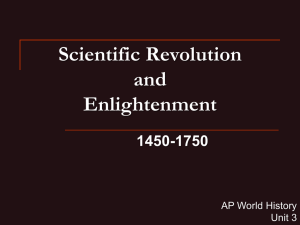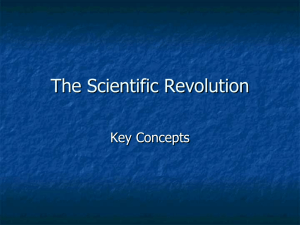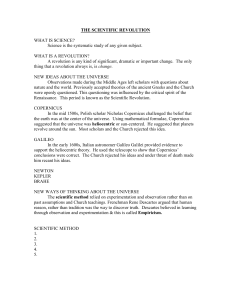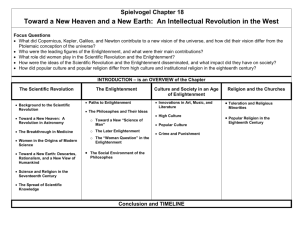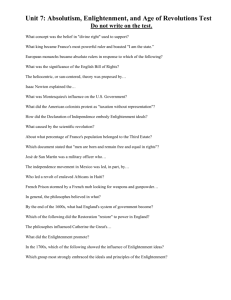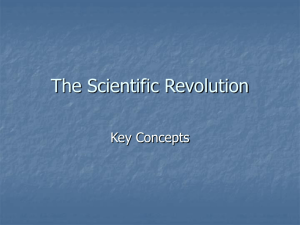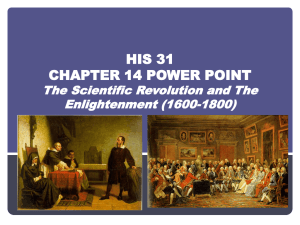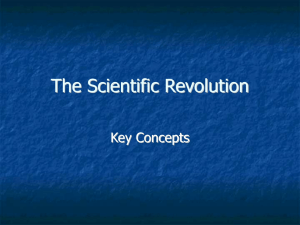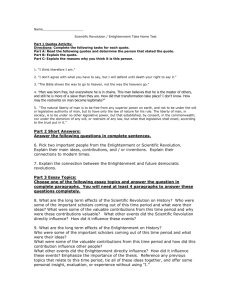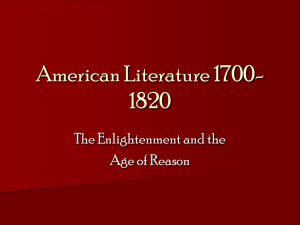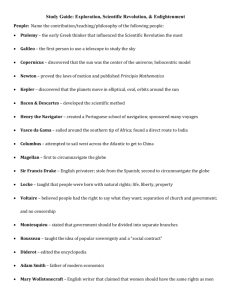The Scientific Revolution
advertisement
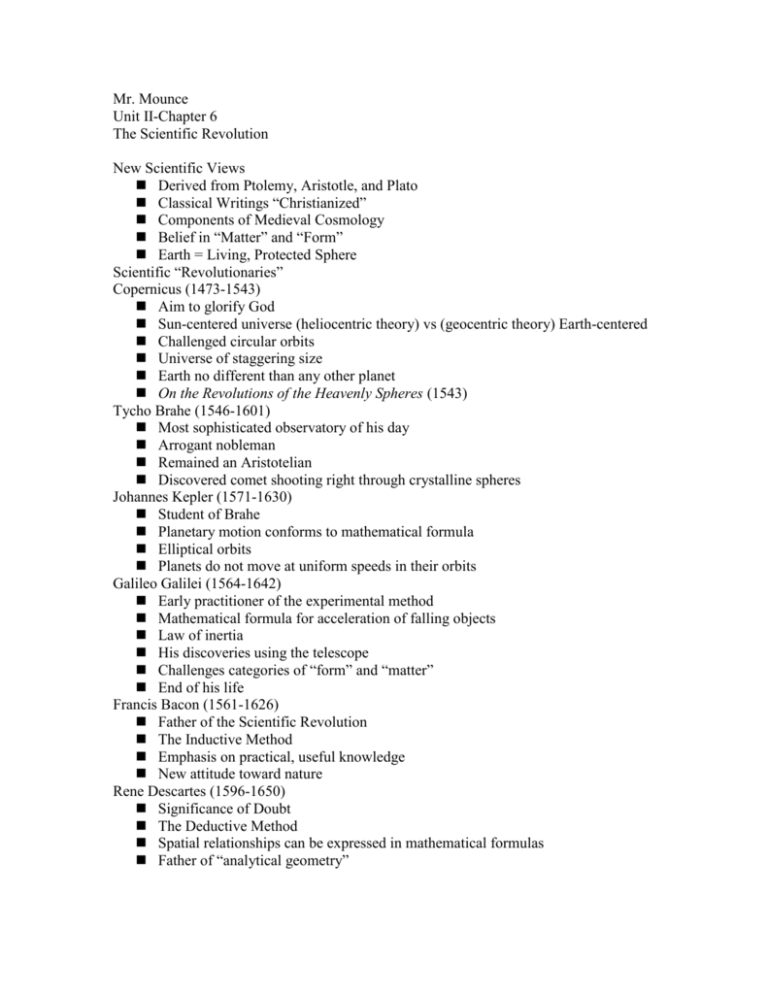
Mr. Mounce Unit II-Chapter 6 The Scientific Revolution New Scientific Views Derived from Ptolemy, Aristotle, and Plato Classical Writings “Christianized” Components of Medieval Cosmology Belief in “Matter” and “Form” Earth = Living, Protected Sphere Scientific “Revolutionaries” Copernicus (1473-1543) Aim to glorify God Sun-centered universe (heliocentric theory) vs (geocentric theory) Earth-centered Challenged circular orbits Universe of staggering size Earth no different than any other planet On the Revolutions of the Heavenly Spheres (1543) Tycho Brahe (1546-1601) Most sophisticated observatory of his day Arrogant nobleman Remained an Aristotelian Discovered comet shooting right through crystalline spheres Johannes Kepler (1571-1630) Student of Brahe Planetary motion conforms to mathematical formula Elliptical orbits Planets do not move at uniform speeds in their orbits Galileo Galilei (1564-1642) Early practitioner of the experimental method Mathematical formula for acceleration of falling objects Law of inertia His discoveries using the telescope Challenges categories of “form” and “matter” End of his life Francis Bacon (1561-1626) Father of the Scientific Revolution The Inductive Method Emphasis on practical, useful knowledge New attitude toward nature Rene Descartes (1596-1650) Significance of Doubt The Deductive Method Spatial relationships can be expressed in mathematical formulas Father of “analytical geometry” Isaac Newton (1642-1727) Universe works like a clock Argues for a universe governed by natural laws Principia; Mathematical Principles of Natural Philosophy (1687) Causes of the Scientific Revolution Medieval Intellectual Life and Medieval Universities The Italian Renaissance Renewed emphasis on mathematics Renaissance system of patronage Navigational problems of long sea voyages Better scientific instruments Consequences of the Scientific Revolution Rise of the “Scientific Community” --Royal Society of London (1662) --Academy of Royal Sciences (1666) The modern scientific method A universe ordered according to natural laws The Enlightenment What was it? Progressive, Rationalistic, Humanistic worldview Emerged out of the Scientific Revolution and culminated in the French Revolution Spokesmen = Rising Middle Class Paris = Center of Enlightenment Optimism about mankind’s abilities Key Ideas Distrust of Tradition and Revealed Religion Scientific method could be applied to society as well Society can get better as risks are taken Man is naturally good Good life is on earth An Attack on the Old Regime Built on tradition World of hierarchy, privilege and inequality Allied with the Church Challenged by the reform impulse of supporters of the Enlightenment Conflict with the Capitalistic Middle Class Support for the Middle Class social order against the traditional social order Size and increasing power of the Middle Class New notion of wealth Tension and discord created by the Middle Class Popularization of Science The popularity of science in the 17th and 18th centuries The Scientific Revolution promised the comprehensibility of the workings of the universe Spreading Ideas The Idea of Progress Most philosophes passionately believed in Locke’s political philosophy and Newton’s scientific theories; they believed in both freedom of speech and the Individual’s right to liberty. The relativity of truth and morality John Locke’s New Psychology --Essay Concerning Human Understanding (1690) -- “Tabula Rasa” The Philosophes 18th century French intellectuals Interest in addressing a broad audience Committed to reform Celebrated the scientific revolution The “Mystique of Newton” Science applied to society The Problem of Censorship The attempt of the Old Regime to control new thinking Publishers and writers hounded by censors Over 1000 booksellers and authors imprisoned in the Bastille in the early 1700’s Battling censorship The Role of the Salon Protection and encouragement offered by French aristocratic women in their private drawing rooms Feminine influence on the Enlightenment Diderot’s Encyclopedia Ultimate strength of the philosophes lay in their numbers, dedication and organization Written between 1751-1772 Attempted to illustrate all human knowledge Problems with publication Emphasis on practical science Desire to change the “general way of thinking” Greater knowledge leads to human progress Emphasized moderation and tolerance Human nature can be molded Inalienable rights and the social contract Knowledge improves goodness Famous Enlightenment Thinkers Baron de Montesquieu (1689-1755) The Spirit of the Laws (1748) Despotism could be avoided if political power were divided and shared by a diversity of classes Power must check power (Separation of Power) Admires British government French parliaments must be defenders of liberty Influence in the US Voltaire (1694-1778) Enthusiasm for English institutions Reformer not a revolutionary Admirer of Louis XIV Relationship with Frederick the Great Father of Satire Jean-Jacques Rousseau (1712-1778) His life Turns his withering critique of the Old Regime increasingly on the Enlightenment itself Rather than liberation, rationalism and civilization destroys the individual Man by nature was solitary, good and free Civilization represents decay, not progress Emile—protect children from too many books The Social Contract (1762) and the “General Will” Civilized man is an alienated man Transitional intellectual figure Enlightened Despotism The manner of political reform Frederick the Great of Prussia Catherine the Great of Russia Joseph II of Austria True reform or a cynical, manipulative consolidation of power? Mary Wollstonecraft The Vindication of the Rights of Women
